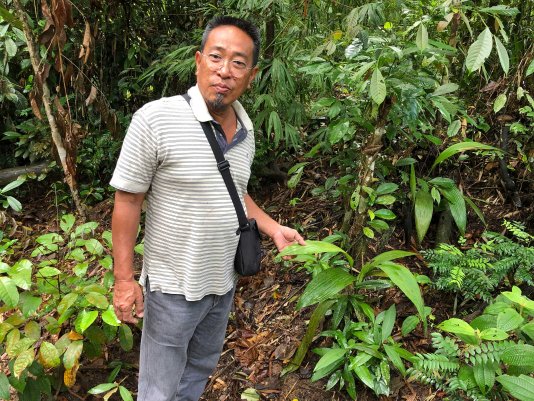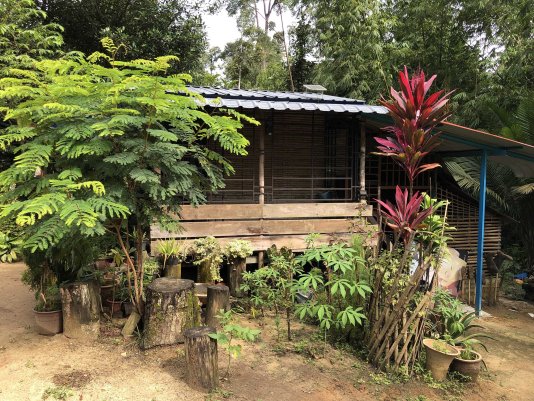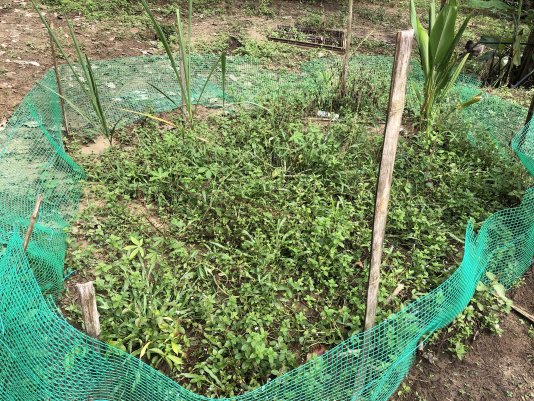- About
- Topics
- Story
- In-Depth
- Picks
- Opinion
- News
- Donate
- Signup for our newsletterOur Editors' Best Picks.Send
Read, Debate: Engage.
| December 26, 2022 | |
|---|---|
| topic: | Deforestation |
| tags: | #Malaysia, #biodiversity, #deforestation, #indigenous lands |
| located: | Malaysia |
| by: | Gabriele Bettinazzi |
Like his ancestors, Wak Apuk has always lived in the forest, and would feel lost outside of it.
A member of the Temuan indigenous community, which has inhabited Malaysia for centuries, Apuk is the chairman of a tiny village in one of the last forested areas outside the capital Kuala Lumpur. The area is one of the few in the country that still boasts native plant and animal species: a plentiful ecosystem that has long provided him and his fellow villagers with food, herbal medicines and a roaming area for activities like hunting, gardening, and farming.
Apuk still needs to hold down a job in construction to make ends meet, but says he’s back in the forest as often as he can.
"I have to work outside because I need money, but my soul is in the forest," he told FairPlanet. "It’s very important to us because it’s our supermarket and pharmacy" as well as a place to explore and decompress.
But this lush biodiverse oasis in the Bukit Cherakah Forest Reserve that has long thrived in symbiosis with the Temuan tribe may soon be further shrunk, as authorities are planning to cut down yet another portion of it to make space for a road and a graveyard - a plan that is likely to weaken the ecology of the entire reserve.
To stop this construction project, a group of activists and residents who live close to the forest in the town of Shah Alam have created the Shah Alam Community Forest Society. Together they are raising awareness about the importance of saving a valuable natural area they claim is still gazetted as a reserve.
The Malaysian government on its part believes it has done everything by the book to degazette and therefore clear the forest, and the High Court has recently sided with it. But the Shah Alam Society has appealed the decision, arguing that the degazettement document should be ruled invalid as it was backdated. As of this reporting the case is still pending.
"We have not progressed much in terms of protection of the forest," Alicia Teoh, the society's founder, acknowledged. "I think we have been quite successful in raising awareness."
She said thousands of people including children and students now hang out at the forest every month for recreational or research purposes, while she barely saw a soul when she first started hiking there in 2014.
"This forest has become very valuable to the community because you no longer have to go to remote areas to experience or study nature, you have it at your doorsteps," she explained, adding that her own house is located just a five-minute drive from it.
Although it is a relatively small patch of about 430 acres, the Shah Alam Community Forest plays a key role in the ecology of the reserve.
With funds from the United Nations Development Programme, the society commissioned a study that proved the forest has a rich animal and plant biodiversity, including hundreds of species like native dipterocarp trees and Malayan tapirs - endangered mammals that are indigenous to the country and contribute to the regeneration of big fruit trees like mangoes and durians by swallowing their seeds whole and dispersing them around the forest while defecating.
"The Shah Alam Community Forest is really special," Dr Teckwyn Lim, a forestry expert who led the study and the society's treasurer, told FairPlanet. He added that unlike most forest patches in the Klang Valley, it can help sustain the population of tapirs roaming around the Bukit Cherakah Forest Reserve.
Tapirs are large animals that can weigh up to 200 kilogrammes and therefore need a huge forested area to find enough food for their survival. The Shah Alam Community Forest seeks to make this easier by acting as an ecological corridor between the northern and southern parts of the reserve, creating a green area of more than 6,000 acres or bigger than 2,200 football pitches.
Severing this connection could put the animals at grave risk, as the two isolated parts may not provide them with a big enough space to survive, cautioned Dr Lim, adding that such an eventuality could potentially affect tree regeneration.
A fragmented forest would also decrease survival chances of other animals like gibbons, because it would isolate the northern population from the southern one and cause inbreeding and expose them to an increased risk of genetic abnormalities.
The ecology of the reserve is already affected by the road cutting across it, as animals like tapirs are often killed in car accidents while trying to cross it. Protecting its biodiversity - as well as the planet’s - would also benefit humans, because a rich variety of species are instrumental in keeping soil fertile and able to produce multiple fruits and vegetables, the expert further said. Biodiversity loss is currently a key threat to humanity on a par with climate change.
Beyond constituting a home to most living species on land, forests help mitigate climate change by taking carbon out of the atmosphere and storing it. They also offer protection against floods.
"Trees tend to slow down water coming from hills so that you don’t get flash floods," said Dr Lim, adding that forests also prevent soil erosion that might clog drains with mud, thus making it harder for water to flow through.
The devastating consequences of deforestation became instantly evident in December 2021 in Hulu Langat, a district to the east of Kuala Lumpur where a Temuan village was ravaged by flash floods and landslides in a disaster villagers attribute to logging operations.
The attempt to clear the Shah Alam Community Forest is a familiar pattern in Malaysia.
The Bukit Lagong forest reserve in Selangor, for instance, could also be destroyed after the government allowed quarrying in the area.
Similarly, the Selangor government degazetted the Kuala Langat North Forest Reserve for development purposes, sparking a public outcry that forced them to reverse the decision.
"There was a big uproar from civil society, so they made a U-turn and promised to re-gazette the Kuala Langat North Forest Reserve, but they haven’t done it yet," said Suresh Kumar, a member of the Defend North Kuala Langat Forest reserve Coalition.
Overall, forests roughly amounting to the size of Singapore have been already earmarked for clearing in peninsular Malaysia, according to the forest monitoring initiative Rimba Disclosure Project (RDP). These will add to the 160,000 forest hectares that have been cut down on the peninsula between 2017 and 2021, Adam, the initiative’s director, told FairPlanet.
Adam prefers to disclose only his first name due to the sensitive nature of the topic.
He added that there is scant information about deforestation in Malaysia, as authorities rarely make data available to the public. "We don’t even know where the forest reserves are," he said.
The initiative is collecting comprehensive data through satellite analysis tools and online advertisement monitoring to provide the public with the intelligence to campaign against deforestation. "I hope my data will help awaken the country and get more action going."
RDP has called for the Department of Environment to meet its own guidelines and publish online the environmental impact assessments of projects that put the environment at risk, but received no response so far.
"I hope my data will help awaken the country and get more action going."
The society's members call for a sensible approach to development that prioritises forest conservation in Shah Alam and throughout the country.
"There are other areas where we can build the graveyard, so we shouldn’t touch the forest as we can’t regrow it," stressed Teoh. She added that there are also alternative ways to reduce traffic congestion in the only road cutting across the reserve, such as improving public transportation and mandating work from home or staggered working hours.
"The congestion is only happening at peak hours, then the rest of the time the roads are empty," she said. "What’s the point of destroying a forest?"
One key measure to protect forests, experts say, is to provide states that refrain from deforestation with financial incentives, because state governments greenlight forest clearing to generate revenue. This policy has been promised by the coalition that has recently formed the new federal government, giving Dr Lim some hope that forest conservation will feature highly on the political agenda.
"It’s important that they implement it soon and increase the amount allocated because the one billion ringgit they promised may not be enough to convince all the states to stop deforestation," he said.
It’s also paramount to preserve forest biodiversity to the greatest extent possible, Adam said. "We can’t allow monoculture plantations in reserve forests because [this means that] you replace thousands of species with just one species. It has zero biodiversity value."
Experts say that similar efforts are needed in order to preserve the lifestyle of indigenous people, which is strongly tied to forests. Authorities often relocate them outside their original forests and provide them with houses that may not suit their traditional way of living.
Apuk agrees that a few indigenous people in his community are not made for living outside the forest, as they struggle to hold down a job due to cultural shock. They can only scratch along by selling produce from the forest.
What indigenous people need is development inside the forest, he stressed, not outside of it, adding that several families who are currently living in the houses built by the government close to the forest as part of a resettlement agreement would like to move to the village.
"We need to build houses [in the village] because our community is increasing," said Apuk.
Suresh echoed his comments. "The problem with the state is that they think they are making indigenous people civilised by turning them into wage earners, and that’s a very wrong concept.
"You must respect their culture and the way they are living instead of thinking they are uncivilised."
By copying the embed code below, you agree to adhere to our republishing guidelines.



